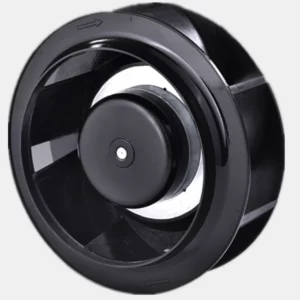A centrifugal dust extractor fan, also known as a centrifugal dust collector or centrifugal dust extractor, is a type of fan specifically designed for removing dust and particulate matter from the air. It is commonly used in industrial settings where airborne dust and particles are generated during manufacturing, processing, or other operations.
The centrifugal dust extractor fan operates based on the principles of centrifugal force. The fan draws in air and particulate-laden air through an inlet or intake duct. The air is then directed into a rotating impeller with blades or vanes. As the impeller spins, the centrifugal force generated causes the dust particles to move towards the outer edge of the impeller.
The dust particles are then separated from the air stream by one of several methods:
- Cyclonic Separation: In this method, the rotating airflow creates a cyclonic motion inside the dust collector. The heavier dust particles are flung outward and collected in a separate chamber or bin, while the cleaned air is discharged through an outlet.
- Filter Media: Some centrifugal dust collectors incorporate filter media, such as fabric bags or pleated cartridges, to capture and retain the dust particles. The air passes through the filter media, allowing the dust to be trapped while the clean air is released.
- Wet Scrubbing: In certain applications, a centrifugal dust extractor fan may utilize a water-based system for dust removal. The dust-laden air is passed through a water spray or mist, which captures the dust particles. The wetted dust is then separated from the air stream, often through settling or centrifugal separation.
Centrifugal dust extractor fans offer several advantages in dust collection applications:
- High Dust Collection Efficiency: The centrifugal force generated by the fan impeller provides effective separation of dust particles from the air stream, resulting in high dust collection efficiency.
- Versatility: Centrifugal dust extractor fans can handle a wide range of dust particle sizes and types, making them suitable for various industrial processes and environments.
- Lower Maintenance: Depending on the specific dust collection method used, centrifugal dust collectors may require less frequent maintenance compared to other types of dust collectors. For example, cyclonic separators may require less filter replacement or cleaning.
- Energy Efficiency: Centrifugal fans are known for their energy-efficient operation, and this applies to centrifugal dust extractor fans as well. They can provide the required airflow and particulate removal with lower power consumption.
- Scalability: Centrifugal dust extractor fans can be designed to accommodate different airflow rates and pressure requirements, allowing for scalability based on the specific application and dust collection needs.
It’s important to note that the design and specifications of centrifugal dust extractor fans can vary based on the specific application, centrifugal dust extractor fan industry requirements, and the type and characteristics of the dust being handled. Consulting with dust collection experts or manufacturers can provide more detailed and tailored information for specific dust extraction needs.
Where is the centrifugal dust collector fan usually used?
Centrifugal dust collector fans are commonly used in various industrial settings where there is a need to remove dust, particulate matter, and airborne contaminants from the air. Here are some typical applications where centrifugal dust collector fans are utilized:
- Manufacturing and Processing Industries: Centrifugal dust collector fans are extensively used in manufacturing and processing industries such as metalworking, woodworking, food processing, pharmaceuticals, chemical production, and cement manufacturing. These industries often generate a significant amount of dust or fine particles during their operations, and the dust collector fans help capture and remove the airborne contaminants, ensuring a safe and clean working environment.
- Woodworking and Sawmills: Woodworking processes, including cutting, sanding, and planing, generate large amounts of sawdust and wood particles. Centrifugal dust collector fans are commonly employed to extract and collect the wood dust, preventing it from accumulating in the air or settling on surfaces, and reducing the risk of fire hazards.
- Metal Fabrication: Metalworking processes such as grinding, cutting, and welding produce metal dust, fumes, and particulates, which can pose health and safety risks. Centrifugal dust collector fans are used to capture and remove these airborne contaminants, protecting workers and maintaining air quality in the facility.
- Mining and Quarrying: Dust generation is a significant concern in mining and quarrying operations. Centrifugal dust collector fans are employed to control and mitigate the spread of dust from mining sites, reducing respiratory health hazards and maintaining environmental standards.
- Foundries: Foundries produce airborne particulate matter from sand casting, mold preparation, and metal pouring processes. Centrifugal dust collector fans help capture and extract the foundry dust, preventing it from being released into the surrounding environment and protecting workers’ health.
- Grain Handling and Agriculture: In grain handling facilities, such as silos, elevators, and mills, centrifugal dust collector fans are used to control and collect grain dust, preventing it from becoming a fire or explosion hazard. In agriculture, these fans are employed to capture dust and agricultural byproducts associated with processes like drying, processing, and handling of crops.
- Pharmaceuticals and Chemicals: Centrifugal dust collector fans are utilized in pharmaceutical and chemical manufacturing facilities to control airborne particles and contaminants that may be hazardous or affect product quality.
These are just a few examples of the industries and applications where centrifugal dust collector fans are commonly used. The specific design and configuration of the dust collector system, including the fan, filtration method, and exhaust system, can vary depending on the requirements and characteristics of the dust or particulate matter being handled.
